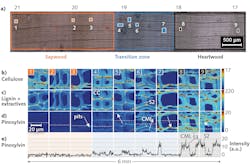WITec award winner finds old growth tree secret using confocal Raman microscopy
In July 2019, microscope and spectrometer manufacturer WITec (Ulm, Germany) awarded top honors—the gold level—in its annual Paper Award to scientists from the University of Natural Resources and Life Sciences (Vienna, Austria) for their work in using confocal Raman microscopy to understand how old-growth trees can live for thousands of years.
After preparing thin sections from old-growth trees in Austria, the scientists used a confocal Raman setup to map (with 300 nm lateral resolution) the chemical constituents of the cellulose, phenolic compounds (including lignin), and pinosylvins within the annual ring layers of the tree. An oil-immersion objective (100X from Carl Zeiss) with a high numerical aperture (NA) of 1.4 was used to achieve high spatial resolution. The imaging setup consisted of a WITec alpha 300RA confocal Raman microscope with an x, y, z piezoelectric scanner and a WITec focused green 532 nm laser; the Raman signal was collected by the same microscope objective that focuses the laser, fed to a WITec UHTS 300 spectrometer, and recorded by a CCD camera.
The orientation of the sample with respect to the laser polarization (the radial direction along the y-axis of the table) is a crucial step as the cellulose signal in the Raman spectrum depends on the laser polarization direction. Raman spectra of the sapwood, heartwood, and transitional regions in a 6 mm tree slice revealed the subcellular distribution pathways—to the submicron level—of pinosylvins and lipids in different parts of the tree sections, demonstrating that the symbiotic relationships between some of these compounds is critical to maintain high impregnation values for certain pest- and decay-deterrent compounds during the tree’s growth cycle that are critical to the overall health and viability of old-growth trees.
Because phenolic compounds in tree rings, such as extractives in heartwood formation, often exhibit strong fluorescence backgrounds that can hide individual spectral peaks, trial measurements of each compound should first be made in order to adjust the laser power, integration time, or excitation wavelength to avoid fluorescence noise or prevent the laser from burning a hole in the sample. Reference: http://bit.ly/WitecRef.
About the Author

Gail Overton
Senior Editor (2004-2020)
Gail has more than 30 years of engineering, marketing, product management, and editorial experience in the photonics and optical communications industry. Before joining the staff at Laser Focus World in 2004, she held many product management and product marketing roles in the fiber-optics industry, most notably at Hughes (El Segundo, CA), GTE Labs (Waltham, MA), Corning (Corning, NY), Photon Kinetics (Beaverton, OR), and Newport Corporation (Irvine, CA). During her marketing career, Gail published articles in WDM Solutions and Sensors magazine and traveled internationally to conduct product and sales training. Gail received her BS degree in physics, with an emphasis in optics, from San Diego State University in San Diego, CA in May 1986.
